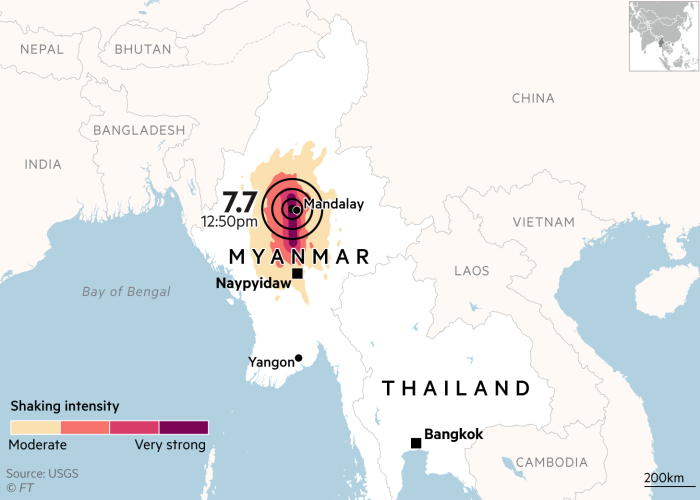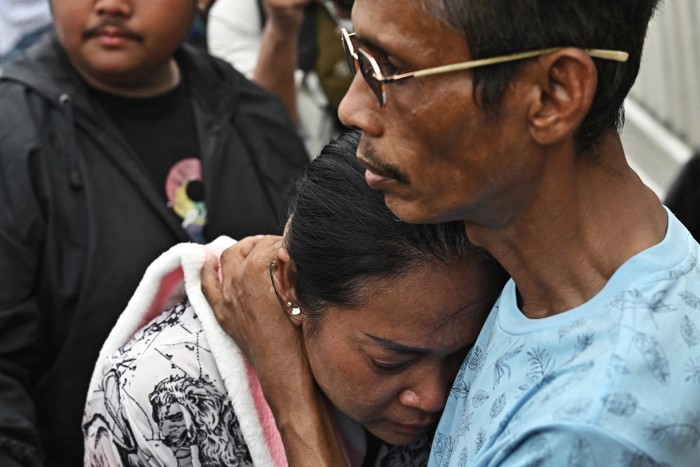International efforts to get aid into Myanmar intensified on Sunday, days after a devastating earthquake that has deepened the crisis in the conflict-stricken country.
Rescue and medical teams from China, Russia, India, Thailand and Singapore arrived in the isolated south-east Asian country. Other regional partners including Vietnam and Malaysia have pledged to send support.
Myanmar’s military government said 1,644 people had been killed and 3,408 injured with 139 more declared missing, according to state media, though those figures are expected to rise.
The quake also caused at least 17 deaths in Bangkok, the Thai capital more than 600 miles away, while another 78 were missing after a high-rise building collapsed.
Aftershocks continued through the weekend, with 5.1 magnitude quakes hitting Mandalay and Naypyidaw, the capital, on Sunday.
Responding to the earthquake is set to be a huge challenge for Myanmar, wracked by conflict for decades, and its repressive military rulers. A UN Development Programme report in January said the country of 55mn people was enduring a “polycrisis”, with its economy in disarray and GDP lower than before the Covid-19 pandemic.
The earthquake “could not come at a worse time for Myanmar”, Amnesty International’s Myanmar researcher Joe Freeman said. He noted that the disaster followed the Trump administration’s move to freeze foreign aid and scale down USAID, though the US president has said that Washington would provide assistance in the wake of the earthquake.
Amnesty estimated that more than one-third of the population would be in need of humanitarian assistance this year.
Myanmar’s military overthrew the elected government of Nobel Peace Prize laureate Aung San Suu Kyi in a coup in 2021. Since then, conflict has deepened across the country as pro-democracy groups have aligned with armed ethnic insurgencies against the junta.
Several strategic border regions are in rebel hands, although the regime’s control is more secure in central regions including Yangon, the commercial hub, and Mandalay, the second city close to the epicentre of Friday’s earthquake.
India said its military had sent a team to set up a field hospital near Mandalay and aircraft with some relief supplies. Its navy is also sending four ships with humanitarian aid.
“Disaster relief material, humanitarian assistance, search & rescue teams are being expeditiously dispatched to the affected areas,” Prime Minister Narendra Modi wrote on X after speaking to General Min Aung Hlaing, the head of Myanmar’s military junta.
Beijing dispatched two emergency rescue teams while China’s Red Cross sent emergency supplies, according to state media. South-western Yunnan province, which borders Myanmar, sent some supplies.
Singapore said it had sent an 80-member team from its civil defence force, which arrived in Naypyidaw on Saturday to assist with search and rescue efforts.

In the past, military governments have refused or restricted access to aid, particularly to areas held by rebel groups.
In 2008, a military dictatorship refused aid, including from the US, after Cyclone Nargis killed more than 100,000 people. During more recent disasters, such as Cyclone Mocha in 2013 and flash flooding last year, local relief workers accused the government of withholding aid and donations to rebel-held areas.
“The junta’s response to Cyclone Mocha and Typhoon Yagi demonstrate its willingness to weaponise aid in the midst of natural disasters,” said Tom Andrews, UN special rapporteur for human rights in Myanmar. “A strong international response is imperative to get aid to the many who were in the crosshairs of this terrible quake.”
The Centre for Ah Nyar Studies, a human rights group focused on central Myanmar, said on Sunday that international aid “has still not reached the hands of the affected people”, with Mandalay residents “carrying out rescue work on their own”.
The group added that some international relief teams were given permission to operate in Mandalay and Naypyidaw from Monday. But it added that Sagaing, a rural northern region bordering Mandalay that has seen the brunt of the fighting, remained “blocked”.


International agencies said that the quake had destroyed hospitals and damaged the main highway between Mandalay and Yangon, the country’s commercial centre. The air traffic control tower at the airport in Naypyidaw collapsed.
“We may not have a clear picture of the extent of damage and loss for some time,” Amnesty said. It added that central Myanmar had been also been “ravaged by military air strikes and clashes between resistance groups and the military”.
Just hours after the earthquake, the military carried out air strikes in areas of northern Shan state, according to local media reports.
The National Unity Government, a shadow government composed of former members of Aung San Suu Kyi’s party, said on Saturday that it would implement a “two-week pause” in offensive military activity in earthquake-affected areas.
It added that it would co-operate with UN agencies and international aid groups “to provide immediate emergency assistance and medical support”, including in junta-controlled areas “if safety guarantees are provided”.
Additional reporting by Chris Kay in Mumbai




